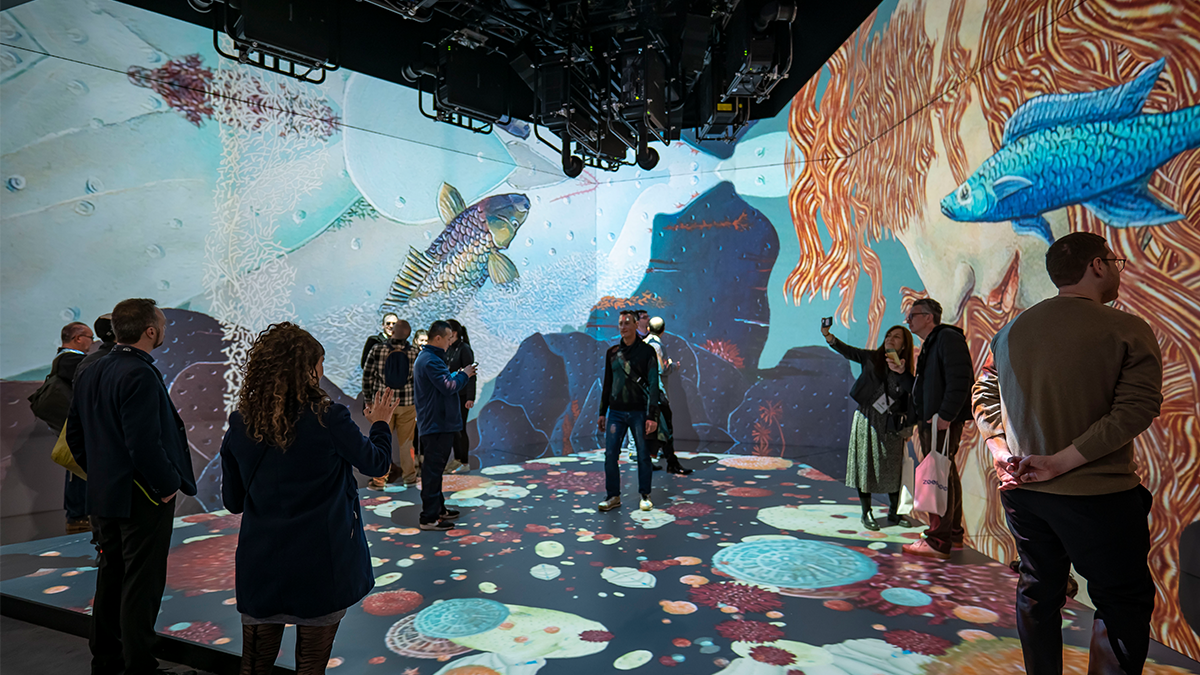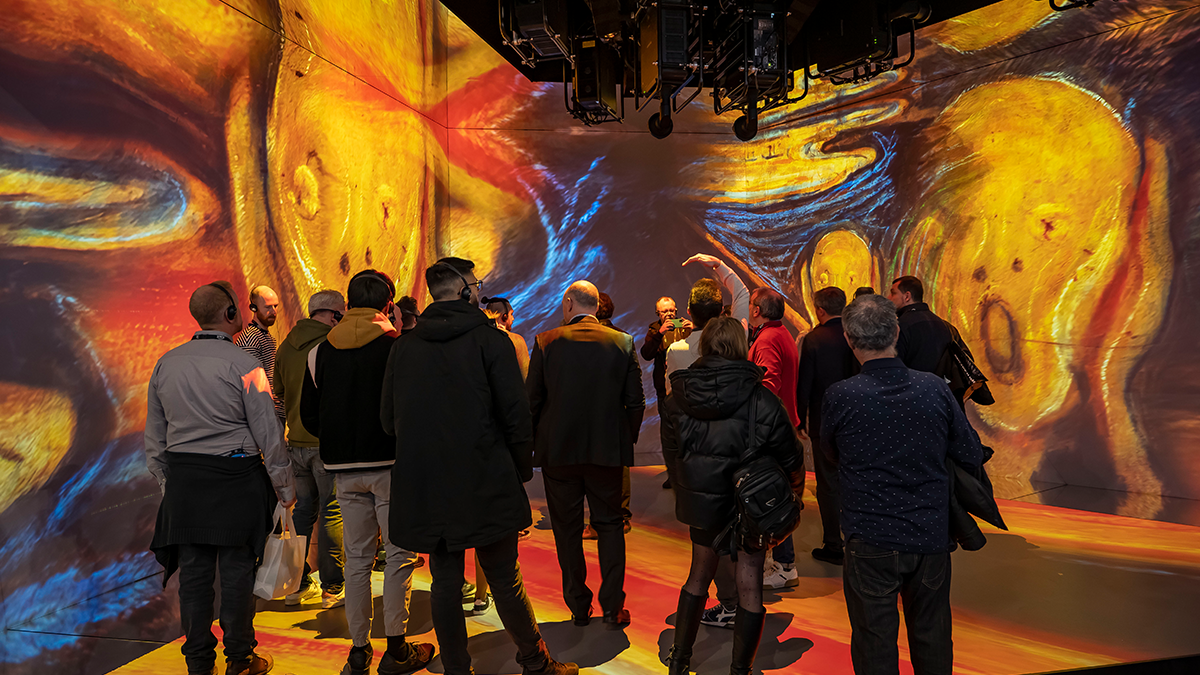Customer Stories
A Tech Double-Take: Two technology solutions used to bring Frameless to ISE 2023
State-of-the-art AV and the latest fully IP-based and synchronised solution on a 10GB fibre network brings the immersive art sensation to life on the road.

The thought of replicating some of the incredible immersive galleries from Frameless, the UK’s largest digital immersive art experience, at the Panasonic stand at ISE 2023 in Barcelona may have seemed a daunting challenge to some. But the same team of partners that created the UK visitor sensation did not stop there. They decided to use the opportunity to show how these cutting-edge immersive experiences could be delivered in two different technological ways: one in a state-of-art AV connection executed in the most sophisticated way and the second demonstrating the latest fully IP based and synchronised solution on a 10GB fibre network infrastructure.
To achieve their goal, Panasonic Connect Europe teamed-up with Hive Media Control, Apantac LLC and Matrox Video. To recreate the Frameless UK experience, Panasonic used three RQ35 and eight RQ25 3-Chip DLP projectors to create the images on the floors and walls respectively. Using Panasonic’s original pixel-quadrupling technology these projectors, the world’s smallest and lightest in their range, produce stunning 4K+ visuals at 20000-30500 lumens. They were positioned in the centre of the area to take up as little space as possible and equipped with Panasonic ultra-short throw lenses (ET-D3LEU100 & ET-D3LEW200) to create stunning visuals without casting shadows. The projectors deliver uniformity in both brightness and colour performance, allowing images to be seamlessly blended, avoiding distractions or blemishes that could break the connection with the viewer. In addition to the immersive experience, the projected images are ideal for capture on video and in photos for social media – helping positive marketing about the exhibition spread virally.
To ensure the best quality visual experience possible, Panasonic worked with LANG AG to develop a high contrast fabric screen material which could be applied to the back wall of the stand - radically improving contrast and colour reproduction. The projectors were fed content from the HIVE media players using SDI, just as in the original installation in London’s Marble Arch. To directly feed SDI to the projectors, Apantac provided Smart Display Module (SDM) input cards for a cleaner set-up requiring less hardware installation. These smart SDM cards are compact and integrated directly into a display or projector, eliminating external signal conversion devices, reducing cabling, and saving space and power.

Showing the potential of IP streaming
To show the potential of IP streaming technology for immersive installations, Matrox Video provided ConvertIP, IPMX-ready encoders and decoders. Matrox Video’s award-winning lineup of media-over-IP appliances provide solutions for today’s most demanding AV-over-IP, broadcast and media, and live webcasting applications.
In this installation, Panasonic used a combination of ConvertIP DSS and DSH devices. Eleven ConvertIP DSS encoders took 1080p60 4:2:2 SDI signals from the HIVE media players, converted the signals to HDMI, and then fed them to a Netgear 4350 network switch. An additional eleven ConvertIP DSH decoders were then used to feed the HDMI signals to the projectors. The projectors were fully synchronized thanks to ConvertIP’s PTP network clock.
“We wanted to show the different opportunities for location-based entertainment when it comes to bringing incredible immersive productions to their audiences, whether it’s fixed installations at museums or travelling art exhibitions,” explained Hartmut Kulessa, European Marketing Manager at Panasonic Visual System Solutions. “We used the regular AV solution that has become common over the past decade, with redundant playout systems created by simply doubling up the servers. But we also wanted to show the potential of AVoIP streaming which can run across multiple sites and can be delivered with a lighter and easier to manage infrastructure.”
Hartmut added that he expects the IPMX standard, used in the Matrox ConvertIP Series encoders, to be one of the de facto standards for live events and fixed installations because of its flexibility and low latency. “Using IPMX, content can be scaled to top quality ST 2110 signals to transmit in a 25GB network, or the same content can be downscaled to fit into a 1GB or 10GB network. With many museums, for example, using a 1GB network this can be a huge advantage because it allows them to use their existing infrastructure to create incredible new visual attractions.”
“We were proud to have had Matrox ConvertIP encoders and decoders play a role in bringing this mesmerizing installation to life," said Alberto Cieri, Senior VP of Global Sales and Marketing at Matrox Video. “Synchronized, orchestrated networks continue to be expensive and complex to install, so the ability to use commercially available equipment is key for delivering simple, interoperable installations.”
“Using IPMX, content can be scaled to top quality ST 2110 signals to transmit in a 25GB network, or the same content can be downscaled to fit into a 1GB or 10GB network.”
- Hartmut Kulessa, European Marketing Manager, Panasonic Visual System Solutions
SDM future-proofs
The use of the SDM cards in its projectors was also an innovative solution that Panasonic was keen to show at ISE to demonstrate its flexible and future-proofed approach. Hartmut explained: “Our strategy is to future-proof our products by enabling customers to use SDM cards to retrofit the projector or display for different uses; for example, with existing standards like STI and future standards like IPMX. Here we worked with Apantac, one of the leading developers of slot-in computing. We are working closely with them to create a variety of SDM cards for our displays and projectors to enable them to be customised for future application needs.”
Panasonic’s ultimate objective was to demonstrate that award winning, fixed installation and cutting edge immersive content like Frameless can be recreated to a high level experience in temporary, new build and traditional infrastructure existing buildings. “It doesn’t always require high budgets, new infrastructure and dedicated buildings,” concluded Hartmut. “We have demonstrated that you can use different approaches and the flexibility of the different technology solutions creates some exciting opportunities.”
I think we can call that mission accomplished.
